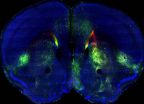(Press-News.org) VIDEO:
A comparative analysis shows that stethoscope diaphragms are more contaminated than the physician's own thenar eminence (group of muscles in the palm of the hand) following a physical examination.
Click here for more information.
Rochester, MN, February 27, 2014 – Although healthcare workers' hands are the main source of bacterial transmission in hospitals, physicians' stethoscopes appear to play a role. To explore this question, investigators at the University of Geneva Hospitals assessed the level of bacterial contamination on physicians' hands and stethoscopes following a single physical examination. The study appears in the March issue of Mayo Clinic Proceedings.
"By considering that stethoscopes are used repeatedly over the course of a day, come directly into contact with patients' skin, and may harbor several thousands of bacteria (including MRSA) collected during a previous physical examination, we consider them as potentially significant vectors of transmission," commented lead investigator Didier Pittet, MD, MS, Director of the Infection Control Program and WHO Collaborating Centre on Patient Safety, University of Geneva Hospitals. "From infection control and patient safety perspectives, the stethoscope should be regarded as an extension of the physician's hands and be disinfected after every patient contact."
In this study, 71 patients were examined by one of three physicians using sterile gloves and a sterile stethoscope. After they completed the examination, two parts of the stethoscope (the tube and diaphragm) and four regions of the physician's hands (back, fingertips, and thenar and hypothenar eminences) were measured for the total number of bacteria present.
The stethoscope's diaphragm was more contaminated than all regions of the physician's hand except the fingertips. Further, the tube of the stethoscope was more heavily contaminated than the back of the physician's hand. Similar results were observed when contamination was due to methicillin-resistant S.aureus (MRSA) after examining MRSA-colonized patients.
This work is the first to compare directly the level of contamination of physicians' hands and stethoscopes. Stethoscope contamination is not trivial and is comparable to the contamination of healthcare workers' fingertips, the hand region most implicated in microbial cross-transmission. Physicians must be aware of the need to disinfect their stethoscope after each use.
INFORMATION:
Physicians' stethoscopes more contaminated than palms of their hands
Results of new study published in Mayo Clinic Proceedings
2014-02-27
ELSE PRESS RELEASES FROM THIS DATE:
Study reveals mechanisms cancer cells use to establish metastatic brain tumors
2014-02-27
NEW YORK, NY, February 27, 2014 — New research from Memorial Sloan Kettering provides fresh insight into the biologic mechanisms that individual cancer cells use to metastasize to the brain. Published in the February 27 issue of Cell, the study found that tumor cells that reach the brain — and successfully grow into new tumors — hug capillaries and express specific proteins that overcome the brain's natural defense against metastatic invasion.
Metastasis, the process that allows some cancer cells to break off from their tumor of origin and take root in a different tissue, ...
Methane leaks from palm oil wastewater are a climate concern, CU-Boulder study says
2014-02-27
In recent years, palm oil production has come under fire from environmentalists concerned about the deforestation of land in the tropics to make way for new palm plantations. Now there is a new reason to be concerned about palm oil's environmental impact, according to researchers at the University of Colorado Boulder.
An analysis published Feb. 26 in the journal Nature Climate Change shows that the wastewater produced during the processing of palm oil is a significant source of heat-trapping methane in the atmosphere. But the researchers also present a possible solution: ...
Famed Milwaukee County Zoo orangutan's death caused by strange infection
2014-02-27
MADISON – Mahal, the young orangutan who became a star of the Milwaukee County Zoo and an emblem of survival for a dwindling species, led an extraordinary life.
It turns out, the young ape died an extraordinary death, too.
Rejected by his biological mother at the Cheyenne Mountain Zoo in Colorado Springs, Colo., and eventually flown to Milwaukee aboard a private jet to live with a surrogate mother, Mahal became one of the Milwaukee County Zoo's star attractions. His unexpected death at age 5 in late December 2012 was a shock to the community that came to know him through ...
Scientists describe deadly immune 'storm' caused by emergent flu infections
2014-02-27
LA JOLLA, CA—February 26, 2014—Scientists at The Scripps Research Institute (TSRI) have mapped key elements of a severe immune overreaction—a "cytokine storm"—that can both sicken and kill patients who are infected with certain strains of flu virus.
Their findings, published in this week's online Early Edition of the Proceedings of the National Academy of Sciences, also clarify the workings of a potent new class of anti-inflammatory compounds that prevent this immune overreaction in animal models.
"We show that with this type of drug, we can quiet the storm enough to ...
Livestock found ganging up on pandas at the bamboo buffet
2014-02-27
VIDEO:
A panda in the Wolong Nature Reserve munches on bamboo -- which comprises 99 percent of the endangered species' diet in the wild.
Click here for more information.
Pandas, it turns out, aren't celebrating the Year of the Horse.
Livestock, particularly horses, have been identified as a significant threat to panda survival. The reason: They're beating the pandas to the bamboo buffet. A paper by Michigan State University panda habitat experts published in this week's Journal ...
Making treatment of rare blood disorder more affordable and effective
2014-02-27
PHILADELPHIA — A University of Pennsylvania research team has defined a possible new way to fight a disease that is currently treatable only with the most expensive drug available for sale in the United States. In a study published this month in Blood, the Penn team describes the strategy, based on the oldest part of the human immune system – called "complement" -- that could turn out to be less costly and more effective for the majority of patients with a rare blood disorder.
Complement is a network of more than 50 proteins in the blood and on cell surfaces that quietly ...
International study shows majority of children unaware of cigarette warning labels
2014-02-27
College Park, Md. -- An international study of children's perceptions of cigarette package warning labels found that the majority of children are unaware that they exist. Children in countries where larger warning labels are used, and which include a compelling graphic image of the negative health impacts of smoking, were more likely to be aware of and understand the health risks of tobacco products.
The study, led by Dina Borzekowski, Ed.D, in the University of Maryland School of Public Health (UMD SPH), and Joanna Cohen, PhD, Johns Hopkins Bloomberg School of Public ...
AGU: A 'shark's eye' view: Witnessing the life of a top predator
2014-02-27
HONOLULU – Instruments strapped onto and ingested by sharks are revealing novel insights into how one of the most feared and least understood ocean predators swims, eats and lives.
For the first time, researchers at the University of Hawaii and the University of Tokyo outfitted sharks with sophisticated sensors and video recorders to measure and see where they are going, how they are getting there, and what they are doing once they reach their destinations. (Go to http://www.youtube.com/watch?v=UHDOAmXRw-0&feature=youtu.be for video).
Scientists are also piloting ...
Mouse brain atlas maps neural networks to reveal how brain regions interact
2014-02-27
Different brain regions must communicate with each other to control complex thoughts and behaviors, but relatively little is known about how these areas organize into broad neuronal networks. In a study published by Cell Press February 27th in the journal Cell, researchers developed a mouse whole-brain atlas that reveals hundreds of neuronal pathways in a brain structure called the cerebral cortex. The online, open access, interactive image database, called the Mouse Connectome Project, provides an invaluable resource for researchers interested in studying the anatomy and ...
Study uncovers why autism is more common in males
2014-02-27
Males are at greater risk for neurodevelopmental disorders, such as autism spectrum disorder (ASD), than females, but the underlying reasons have been unclear. A large cohort study published by Cell Press on February 27th in the American Journal of Human Genetics provides compelling evidence in support of the "female protective model," which proposes that females require more extreme genetic mutations than do males to push them over the diagnostic threshold for neurodevelopmental disorders.
"This is the first study that convincingly demonstrates a difference at the molecular ...
LAST 30 PRESS RELEASES:
Making lighter work of calculating fluid and heat flow
Normalizing blood sugar can halve heart attack risk
Lowering blood sugar cuts heart attack risk in people with prediabetes
Study links genetic variants to risk of blinding eye disease in premature infants
Non-opioid ‘pain sponge’ therapy halts cartilage degeneration and relieves chronic pain
AI can pick up cultural values by mimicking how kids learn
China’s ecological redlines offer fast track to 30 x 30 global conservation goal
Invisible indoor threats: emerging household contaminants and their growing risks to human health
Adding antibody treatment to chemo boosts outcomes for children with rare cancer
Germline pathogenic variants among women without a history of breast cancer
Tanning beds triple melanoma risk, potentially causing broad DNA damage
Unique bond identified as key to viral infection speed
Indoor tanning makes youthful skin much older on a genetic level
Mouse model sheds new light on the causes and potential solutions to human GI problems linked to muscular dystrophy
The Journal of Nuclear Medicine ahead-of-print tip sheet: December 12, 2025
Smarter tools for peering into the microscopic world
Applications open for funding to conduct research in the Kinsey Institute archives
Global measure underestimates the severity of food insecurity
Child survivors of critical illness are missing out on timely follow up care
Risk-based vs annual breast cancer screening / the WISDOM randomized clinical trial
University of Toronto launches Electric Vehicle Innovation Ontario to accelerate advanced EV technologies and build Canada’s innovation advantage
Early relapse predicts poor outcomes in aggressive blood cancer
American College of Lifestyle Medicine applauds two CMS models aligned with lifestyle medicine practice and reimbursement
Clinical trial finds cannabis use not a barrier to quitting nicotine vaping
Supplemental nutrition assistance program policies and food insecurity
Switching immune cells to “night mode” could limit damage after a heart attack, study suggests
URI-based Global RIghts Project report spotlights continued troubling trends in worldwide inhumane treatment
Neutrophils are less aggressive at night, explaining why nighttime heart attacks cause less damage than daytime events
Menopausal hormone therapy may not pose breast cancer risk for women with BRCA mutations
Mobile health tool may improve quality of life for adolescent and young adult breast cancer survivors
[Press-News.org] Physicians' stethoscopes more contaminated than palms of their handsResults of new study published in Mayo Clinic Proceedings




